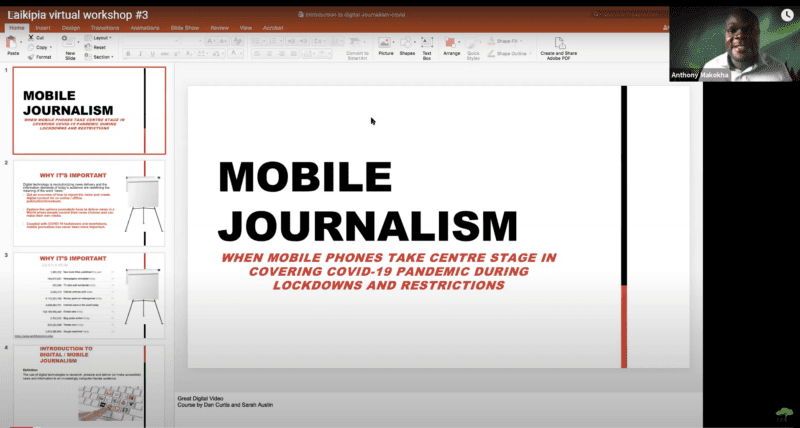When people picture Kenya, they typically image the rugged landscapes teeming with wildlife and ever-flowing rivers of the Maasai Mara, home to the great wildebeest migration.
But Northern Kenya, an area straddling several arid and semi-arid counties, also serves up plenty of wildlife – and lessons in conservation.
It’s here, in Laikipia, that Internews’ Earth Journalism Network had planned to host a workshop focused on conservation and the wildlife trade as part of its East Africa Wildlife Journalism project. Then Covid-19 halted travel, forcing us to come up with creative ways to engage with our network virtually.
We decided to retain much of our original agenda, which offered sessions on the region’s unique biodiversity, including the last remaining wild dogs in Africa, the endangered Grevy’s Zebra, and the reticulated giraffe.
It’s also home to the Mpala Research Center, an expansive “living lab” that draws scientists, students, and researchers from around the world eager to study the various species that live there.
By May, when it became apparent that the pandemic was not going away, we reluctantly decided that the workshop would take place, not amid the acacia-dressed plains dotted with wildlife, but by video conference call.
So how do you take a week-long, in-person training, put it online and hope that people still show up, stay engaged and learn something?
You experiment.
We had already selected our 12 participants through an open call for applications from journalists based in Rwanda, Kenya, Uganda and Tanzania. And we started by asking them questions about how many days a week, when and for how many hours would they be likely to join a virtual workshop.
The poll revealed that sessions needed to be short – they were all working journalists, after all. But we had a lot of information to get through. We ended up spreading the training over three weeks (two hours a session, two sessions a week), and we kicked if off in earnest on June 26 with a roundtable discussion among a group of editors from across East Africa.
Many of them worked on the environment and conservation beat and said they struggled to get story submissions that could compete with politics, crime and corruption.
Sometimes that’s because environmental stories are too technical, they said; other times they’re just not compelling. Bernard Mwinzi, the Managing Editor of the Weekend section at Nation Media Group in Kenya urged journalists to humanize environmental stories by adding color and conflict to attract front page treatment.
The next session on June 29, launched our journalism workshop, and every Monday and Wednesday through to July 15 we logged into Zoom for a mix of presentations and discussions.
In planning, we thought through ways to keep participants active and attentive. Fortunately, our speakers and experts in wildlife conservation and journalism were all lively and easy to listen to. We also made sure to leave plenty of time for questions and feedback.
One of the great features of virtual trainings is that you can record the sessions. We sent these recordings, together with presentations and resources, to the participants once they were completed. This resource email became a lifeline and in important way of staying connected to participants.
We also offered “homework” in the form of reading assignments and practical exercises that we would discuss at the next session. This practice saved on time and ensured that participants were gaining new journalism skills.
Unfortunately, the field trips that are the hallmark of EJN’s trainings and that help participants witness first-hand the information they learn about through the lessons, are harder to replace.
Instead, we maintained our focus on community conservancies and organized a webinar in partnership with the Northern Rangelands Trust that brought in researchers and staff from these facilities. Over the two-hour event, speakers candidly shared their love of wildlife and explained why they have dedicated their lives to saving it, despite some some people in these same areas killing the animals for food and trade.
In all, was saw a 75 percent attendance rate over the course of our three-week training, and in a closing poll the majority of the participants said they were happy with the way the workshop was conducted. They also approved of the choice of presenters, some of them researchers from Mpala like Rosemary Warungu, who studies Grevy’s zebras, and Dedan Ngatia, an expert on wild dogs.
They also appreciated the interactive sessions aimed at enhancing their journalism skills, including one on writing story proposals and telling solution-focused stories and another on how to use their phone to create short mobile-phone-based pieces.
“It was interesting to learn about the various technologies that various stakeholders are employing to conserve wildlife,” one participant said at the end of the training.
Another said she planned to pursue stories about the efforts scientists ae suing to protect wild dogs and Grevy’s zebras.
Virtual trainings can never fully replace in-person engagements, but when faced with few other options, technology and innovation came in handy to keep us providing outreach to the reporters behind these important stories.
“Digital reporting is becoming a necessity,” one of the participants said in response to a survey. And it’s something we’ll be talking about a lot more at EJN as well.
